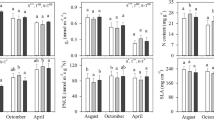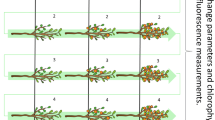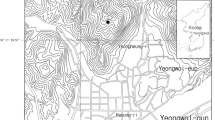Abstract
The relative autonomy of branches within an individual plant may favor different resource allocation responses after reproductive losses. The assessment of these reproductive strategies at the branch level before their integration at the plant level would provide more insight into how plants deal with reproductive losses. Here, we present a field experiment to assess changes in the allocation strategies at the branch level after sink strength manipulation in a Mediterranean woody plant (Cistus ladanifer). We applied three levels of removal of developing fruits (75, 25 and 0 %) on branches of the same plants, and measured their effects on resource allocation (biomass, nitrogen and phosphorus) and seed production after controlling for the effects of branch diameter and leaf weight per branch. Our results suggest that after experimental fruit thinning, C. ladanifer branches presented a sink-driven allocation of biomass to fruits but this was not the case for the allocation of nutrients to seeds, which could be driven by competition with leaf biomass. Reductions in biomass per fruit resulted in a reduction in seed output since the average weight per seed remained constant. From these results, it could be suggested that an heterogeneous distribution of fruit losses among the branches within a crown would produce a higher impact on reproductive output than a more equitable distribution.


Similar content being viewed by others
References
Acosta FJ, Delgado JA, López F, Serrano JM (1997) Functional features and ontogenetic changes in reproductive allocation and partitioning strategies of plant modules. Plant Ecol 132:71–76
Austin RB (1966) The growth of watercress (Rorippa nasturtium aquaticum (L) Hayek) from seed as affected by the phosphorus nutrition of the parent plant. Plant Soil 24:113–120
Bolland MDA, Paynter BH (1990) Increasing phosphorus concentration in seed of annual pasture legume species increases herbage and seed yields. Plant Soil 125:197–205
Calvo L, Tarrega R, Luis E, Valbuena L, Marcos E (2005) Recovery after experimental cutting and burning in three shrub communities with different dominant species. Plant Ecol 180:175–185
Delgado JA, Serrano JM, López F, Acosta FJ (2001) Heat shock, mass-dependent germination, and seed yield as related components of fitness in Cistus ladanifer. Environ Exp Bot 46:11–20
Delgado JA, Serrano JM, López F, Acosta JF (2008) Seed size and seed germination in the Mediterranean fire-prone shrub Cistus ladanifer. Plant Ecol 197:269–276
Devlin B, Stephenson AG (1987) Sexual variations among plants of a perfect-flowered species. Am Nat 130:199–218
El-Keblawy A, Lovett-Doust J (1996) Resource re-allocation following fruit removal in cucurbits: patterns in cantaloupe melons. New Pyhtol 134:413–422
Fang XW, Yuan JL, Wang G, Zhao ZG (2006) Fruit production of shrub, Caragana korshinskii, following above-ground partial shoot removal: mechanisms underlying compensation. Plant Ecol 187:213–225
Génard M, Dauzat J, Franck N, Lescourret F, Moitrier N, Vaast P, Vercambre G (2008) Carbon allocation in fruit trees: from theory to modelling. Trees 22:269–282
Hanley ME, Fenner M, Ne’eman G (2001) Pregermination heat shock and seedling growth of fire-following Fabaceae from four Mediterraenan-climate regions. Acta Oecol 22:315–320
Heuvelink E (1997) Effect of fruit load on dry matter partitioning in tomato. Sci Hortic 69:51–59
Hoch G (2005) Fruit-bearing branchlets are carbon autonomous in mature broad-leaved temperate forest trees. Plant Cell Environ 28:651–659
Hoch G, Keel SG (2006) C-13 labelling reveals different contributions of photoassimilates from infructescences for fruiting in two temperate forest tree species. Plant Biol 8:606–614
Hochwender CG, Sork VL, Marquis RJ (2003) Fitness consequences of herbivory on Quercus alba. Am Midl Nat 150(2):246–253
Lacointe A, Deleens E, Ameglio T, Saint-Joanis B, Lelarge C, Vandame M, Song GC, Daudet FA (2004) Testing the branch autonomy theory: a 13C/14C double-labelling experiment on differentially shaded branches. Plant Cell Environ 27:1159–1168
Landhäusser SM (2011) Aspen shoots are carbon autonomous during bud break. Trees 25:531–536
Lord JM, Westoby M (2006) Accessory costs of seed production. Oecologia 150:310–317
Lowenberg GJ (1994) Effects of floral herbivory on maternal reproduction in Sanicula arctopoides (Apiaceae). Ecology 75:359–369
Marsal J, Mata M, Arbones A, Rufat J, Girona J (2002) Regulated deficit irrigation and rectification of irrigation scheduling in young pear trees: an evaluation based on vegetative and productive response. Eur J Agron 17:111–122
Marsal J, Basile B, DeJong TM (2003) Influence of branch autonomy on fruit, scaffold, trunk and root growth during Stage III of peach fruit development. Tree Physiol 23:313–323
Marsal J, Mata M, Arbones A, Del Campo J, Girona J, López G (2008) Factors involved in alleviating water stress by partial crop removal in pear trees. Tree Physiol 28:1375–1382
Millard P, Grelet GA (2010) Nitrogen storage and remobilization by trees: ecophysiological relevance in a changing world. Tree Physiol 30:1083–1095
Nombela G, Navas A, Bello A (1994) Structure of the nematofauna in Spanish Mediterranean Continental soils. Biol Fertil Soils 18:183–192
Obeso JR (1998) Effects of defoliation and girdling on fruit production in Ilex aquifolium. Funct Ecol 12:486–491
Obeso JR (2004) A hierarchical perspective in allocation to reproduction from whole plant to fruit and seed level. Perspect Plant Ecol Evol Syst 6:217–225
Obeso JR (2012) Mineral nutrient stoichiometric variability in Hedera helix (Araliaceae) seeds. Ann Bot 109(4):801–806
Oitate H, Noguchi Km Sone K, Terashima I, Suzuki AA (2011) Patterns of photoassimilate translocation to reproductive shoots from adjacent shoots in Camellia sasanqua by manipulation of sink-source balance between the shoots. J Plant Res 124:131–136
Pilson D, Decker KL (2002) Compensation for herbivory in wild sunflower: response to simulated damage by the head-clipping weevil. Ecology 83:3097–3107
Radojevic M, Bashkin V (1999) Practical environmental analysis. Royal Society of Chemistry, Cambridge
Sadras VO (1996) Cotton compensatory growth after loss of reproductive organs as affected by availability of resources and duration of recovery period. Oecologia 106:432–439
Silvertown J (1989) The paradox of seed size and adaptation. Trends Ecol Evol 4:24–26
Talavera S, Gibbs PE, Herrera J (1993) Reproductive biology of Cistus ladanifer (Cistaceae). Plant Syst Evol 186:123–134
Trueman SJ, Wallace HM (1999) Pollination and resource constraints on fruit set and fruit size of Persoonia rigida (Proteaceae). Ann Bot 83:145–155
Valladares F (1999) Architecture, ecology, and evolution of plant crowns. In: Pugnaire FI, Valladares F (eds) Handbook of functional plant ecology. Marcel Dekker Inc, New York, pp 121–194
Volpe G, Bianco LB, Rieger M (2008) Carbon autonomy of peach shoots determined by C13-photoassimilate transport. Tree Physiol 28:1805–1812
Watson MA (1986) Integrated physiological units in plants. Trends Ecol Evol 1:119–123
Wise MJ, Cummins JJ, De Young C (2008) Compensation for floral herbivory in Solanum carolinense: identifying mechanisms of tolerance. Evol Ecol 22:19–37
Acknowledgments
Financial support was provided by CGL2009-10392 (Spanish Ministry of Science and Innovation) and REMEDINAL-3 (P2013/MAE-2719 http://www.remedinal.org/) projects.
Author information
Authors and Affiliations
Corresponding author
Additional information
Communicated by S Renault.
Tragically, our dear friend Luis Balaguer passed away on March 19, 2014. We dedicate this contribution to his memory.
Electronic supplementary material
Below is the link to the electronic supplementary material.
Rights and permissions
About this article
Cite this article
Catalán, P., Delgado, J.A., Jiménez, M.D. et al. Sink strength manipulation in branches of a Mediterranean woody plant suggests sink-driven allocation of biomass in fruits but not of nutrients in seeds. Acta Physiol Plant 38, 193 (2016). https://doi.org/10.1007/s11738-016-2220-9
Received:
Revised:
Accepted:
Published:
DOI: https://doi.org/10.1007/s11738-016-2220-9




